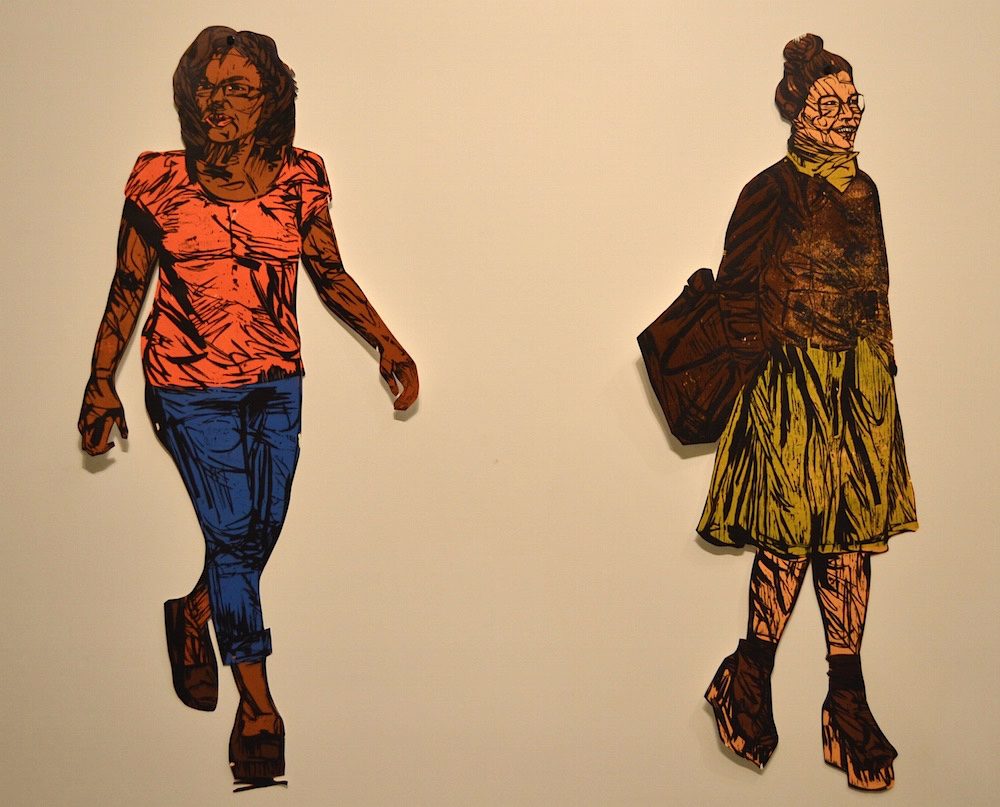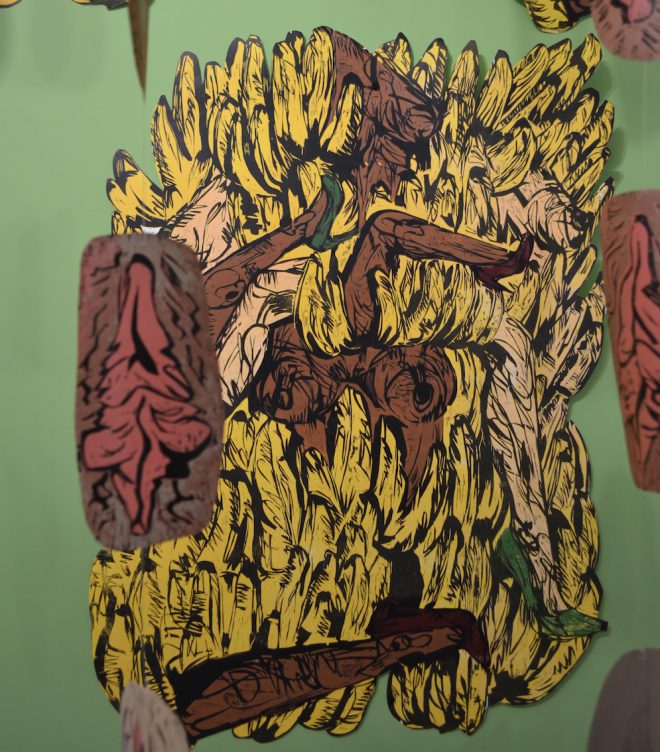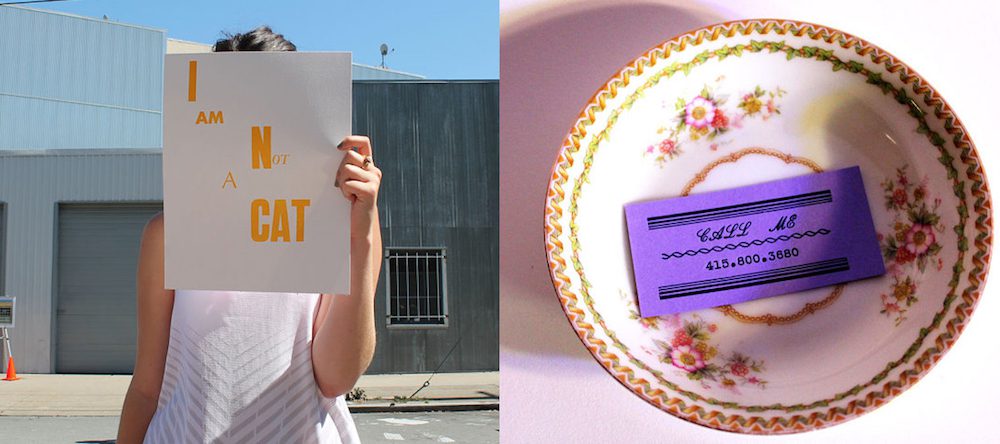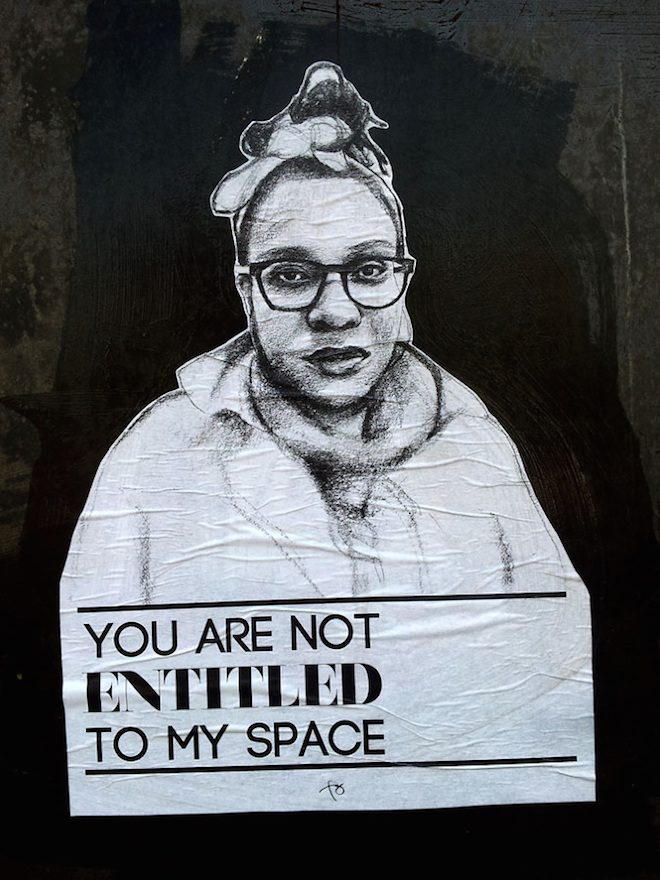Indecent Intentions: Street Harassment and Contemporary Art
Ashton Cooper uses Katrina Andry’s latest exhibition at Staple Goods as a lens to explore how street harassment is being addressed in contemporary art and visual culture.

Installation view of Katrina Andry's "Indecent Intentions Leave Me Vulnerable and Voiceless" at Staple Goods, New Orleans. Photo by Katrina Andry.
In 1986, Adrian Piper began handing out small cards in bars when, after repeated rebuffs, individuals continued to make unwelcome advances. “Dear Friend,” they read. “I am not here to pick anyone up, or to be picked up. I am here alone because I want to be here, ALONE.”
Existing as both a work of art and as a practical defense, Piper’s cards foreshadow the types of actions many artists and activists have used since to combat such unwanted attention. While the term street harassment was barely in the general lexicon when Piper created My Calling (Card) #2 (for Bars and Discos), today it is common parlance. With the founding of organizations like Stop Street Harassment and Hollaback! in the past decade and an explosion of media attention around the term in the last year in particular, awareness of the peril of simply walking-while-female is arguably at an all time high. (See: Tatyana Fazlalizadeh’s Stop Telling Women to Smile wheat pastes; Hollaback!’s viral video “10 Hours of Walking in NYC as a Woman”—more on that later; or Jessica Williams’s catcalling segment on the Daily Show.)
But even while public conversation around the topic has increased dramatically, 30 years after Piper’s project, many women artists are still finding it necessary to use their practices to address a problem that shows no signs of subsiding.
“I work Uptown where I can count how many times people are stopping me,” says New Orleans-based artist Katrina Andry, whose exhibition “Indecent Intentions Leave Me Vulnerable and Voiceless” is on view at Staple Goods through March 8. “It started to really get to me. Whether its harmless or not, the underlying motive of why they’re getting my attention is disingenuous.”
Andry’s experiences prompted her to create an installation that was targeted at catcallers. Bright walls and a grid of prints reflect the ludicrous notion that the streets are a “jungle” from which women can be hunted, Andry explains. In order to gain closer access to the five lushly rendered prints of high-heeled legs and naked breasts erupting from behind a jumble of bananas, viewers have to wade through what she calls “meaty” illustrations of vaginas hanging down from the ceiling.

Installation view of Katrina Andry's "Indecent Intentions Leave Me Vulnerable and Voiceless" at Staple Goods, New Orleans. Photo by Katrina Andry.
While this is Andry’s first project to tackle street harassment explicitly, she is using imagery typical to her practice, like the bananas, to reference a history of oppression. “Most of my prints are about how stereotypes perpetuated by whites negatively affect minorities. The objectification of black women’s bodies carries on today. Knowing that history—how you were objectified by the person who owned you and now you’re objectified by your own community—it does not feel good. No lesson was learned. Only the bad was passed on.”
Andry’s need to make art on the subject was also provoked by the feeling of voicelessness she references in the show’s title. “When you feel like someone is verbally harassing you, do you defend yourself?” she queries. “Do you tell them your story? Or why you think it’s not okay for them to yell at you? Is it worth it?” Andry’s questions are echoed again and again when women discuss the experience of being harassed on the street. That inability to act in the moment—the sense of futility and fear that a response will escalate an already unwanted interaction—is exactly why artmaking can be such an effective way to react to the experience—it allows the harassed to talk back from a position of safety and strength. Artmaking can be a way of “taking back the power that was being taken from me,” as filmmaker Maggie Hadleigh-West puts it in her 1998 film War Zone, which was recently screened as part of a series by the New Orleans Film Society.

Images from Mirabelle Jones' project I am not a cat, 2012. Courtesy www.MirabelleJones.com.
“This art is coming from a position of outrage, of wanting to say something or do something and being unable to do it in that moment,” explains Los Angeles-based artist and sexual assault and domestic violence advocate Mirabelle Jones who began handing out cards to catcallers (à la Piper) in her 2012 project I Am Not A Cat. Jones created the small purple cards, which read “call me” in a flirty script, as a tool not just for herself but for others struggling to deal with how to react to catcalling. When the offender calls the number, he or she is greeted by a voicemail message containing pre-recorded responses to catcallers that Jones collected from people affected by the issue. Like Andry’s installation, and much of the art I’ve come across on the topic, the project takes a didactic position, but also simultaneously functions as a unifier of those who have been harassed.
Importantly, Jones’s project made a point of including a wide swath of experiences, including those of men. “I identify as queer so I am always on the lookout for reducing a feminist dialogue to just women and not including trans folk in particular or minimizing dialogues for people of color,” Jones says. “How catcalling affects queers is something I’m very interested in. There’s not a lot of information yet and so much of the dialogue has been around cisgendered women.” Jones’ point is a vital one, lest we fail to recognize the necessity of broadening the discussion to acknowledge and validate the experiences of queer, male-identified, and trans people.
While it may be slow going, we are making important steps to move the conversation beyond privileging the experiences of white women—most recently evidenced in the public outcry against Hollaback!’s viral “10 Hours” video. When it became clear that most of the white men had been edited out, critics were quick to point out how the video thus recreated the historical stereotype of white victim, perpetrator of color, which (whether intentionally or not) vilified men of color and simultaneously marginalized the experiences of others experiencing harassment. Blair Dorosh-Walther’s film Out In The Night, which was released last summer, notably chronicles the experiences of the “New Jersey 4,” black lesbians who were imprisoned after defending themselves against street harassment. And perhaps the most high profile project to focus on foregrounding the experiences of women of color is Tatyana Fazlalizadeh’s Stop Telling Women to Smile, which has featured non-white women’s portraits alongside captions that directly speak to would-be offenders, on walls throughout the world.

Image from Tatyana Fazlalizadeh’s ongoing project Stop Telling Women to Smile. Courtesy www.tlynnfaz.com.
“Street art, particularly Stop Telling Women to Smile, is effective in combating street harassment because it tackles it in the very environment that women experience this harassment—outdoors,” says Fazlalizadeh. “It forces women's stories into the public conversation in a more tangible way by taking the conversation from online and putting it in the streets.”
This ability to both reclaim public space and spark wide-reaching dialogue has made street art an appealing tool for both artists and non-artist activists. The Mannheim, Germany-based group Girl Gangs Against Street Harassment don’t consider themselves artists, but started using wheat pastes in the spring of 2014 to provoke conversation on the issue. “In Germany the discussion about street harassment is rather new,” explains group founder Tobi Funke.
The group has created life-size wheat pastes of women wielding axes, pipes, and bricks. (Their tactic also calls to mind artist Suyin Looui’s revenge fantasy video game Hey Baby from 2010 in which a female user could literally shoot down catcallers.) The style of the posters references 1970s exploitation films (see: Switchblade Sisters), but the image of the girl gang is also “a symbol of solidarity,” according to Funke. “The posters can give people affected by street harassment a voice—a “fuck you” to harassers or a “be safe, we're with you” to everyone else,” says Funke.
The Girl Gang images are available to download on the group’s website and, in less than a year, new iterations of the group have already popped up in Frankfurt, Hamburg, Leipzig, Stuttgart, Heidelberg, Copenhagen, Gothenburg, Kiel, and Graz, among other cities.
“Art has had a lot to do with the increase of discussion surrounding street harassment,” says Jones. “Making the problem visible is essential in order to recognize we aren’t dealing with a series of isolated incidents we are dealing with something society has engineered.”
Editor's Note
Katrina Andry’s “Indecent Intentions Leave Me Vulnerable and Voiceless” is on view through March 8, 2015 at Staple Goods (1340 St. Roch Avenue) in New Orleans.



